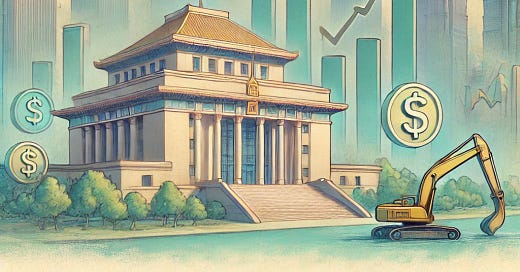China Activates Emergency Measures to Revive the Ailing Housing Sector
The monetary policy easing also aims to deliver essential stimulus by injecting $142 into the economy, as overall growth has fallen short of expectations, particularly when contrasted with India.
Chinese Central Bank Swings Into Action to Rescue Housing Sector
Introduction
China’s central bank, the People's Bank of China (PBOC), today unveiled a comprehensive package of monetary stimulus measures aimed at reviving the country's struggling housing sector and wider economy. The move comes as the property market continues to falter, with broader economic data reflecting a slowdown. This brief piece explores the scope of the PBOC's interventions, the challenges prompting these actions, and the potential outcomes for both the domestic and global economy.
The Scope of the PBOC's Measures
Reserve Requirement Ratio (RRR) Cut
One of the key pillars of the PBOC's latest move is a cut to the Reserve Requirement Ratio (RRR), allowing banks to lend more freely. By lowering the RRR by 50 basis points, the central bank is releasing approximately $142 billion into the financial system. This injection of liquidity is expected to provide much-needed capital to stimulate lending, particularly in the embattled property sector. Additional RRR cuts of 0.25 to 0.5 percentage points are expected later in the year, further bolstering credit availability.
Interest Rate Reductions
In a simultaneous effort to ease financial conditions, the PBOC has also announced cuts to various interest rates. The seven-day repo rate, a benchmark rate for short-term borrowing, has been lowered to 1.5%, while the medium-term lending facility rate will see a 30 basis point reduction. Furthermore, the loan prime rate will be reduced by 20 to 25 basis points, providing more affordable borrowing options to consumers and businesses alike.
Property Market Support
Given the critical role of real estate in China’s economy, specific measures have been directed at this sector. These include a 50 basis point reduction in interest rates for existing mortgages and a cut in the minimum down payment requirement to just 15%. These moves are designed to alleviate pressure on current homeowners and to spur new purchases, potentially reversing the ongoing slump in property prices.
Reasons Behind the Emergency Measures
Deflationary Pressures and Economic Stagnation
China’s economy is facing deflationary pressures as consumer demand weakens and prices fall. With the country at risk of missing its annual growth target of 5%, these measures are designed to inject fresh momentum into the economy, particularly through the revival of the housing market, a sector that contributes significantly to GDP.
Property Market Crisis
China’s property market, which once drove rapid economic growth, has been in free fall since 2021. Several major developers have defaulted, home prices have slumped, and consumer confidence has plummeted. The central bank’s package of support aims to stabilise this pivotal sector and restore faith among buyers and developers.
Weak Consumer Confidence and Disappointing Data
Weak consumer confidence, exacerbated by the property crisis, has weighed heavily on broader economic activity. Recent economic data, especially from August, has consistently fallen short of expectations. These monetary stimulus measures are an urgent attempt to offset these negative trends and boost economic activity in the latter half of the year.
Market Response
Positive Reaction in Chinese Markets
The market’s initial response to the PBOC’s interventions has been broadly positive. China’s major stock indices surged, with the CSI300 blue-chip index and the Shanghai Composite Index both rising nearly 4%. Hong Kong’s main index also saw similar gains, while the yuan strengthened to a 16-month high. These short-term market movements indicate that investors believe the stimulus will provide a temporary boost to economic activity.
Global Market Impact
The reverberations of China’s stimulus measures have been felt globally, with commodity prices like iron ore and copper rising on expectations of increased demand from China. Miners and luxury goods companies, which are heavily reliant on Chinese consumption, have seen stock price gains in response to the announcement.
Challenges and Future Outlook
Uncertainty Around Long-Term Impact
Despite the initial optimism, questions remain regarding the long-term effectiveness of these measures. Many analysts have revised down their growth forecasts for China, with some investment banks predicting growth rates below the 5% target for 2024. There is also widespread belief that without aggressive fiscal measures, monetary stimulus alone may not be sufficient to sustain economic growth.
Global Economic and Trade Implications
China’s economic struggles are compounded by its ongoing trade tensions with the United States, including tariffs on key Chinese exports. These global headwinds, combined with domestic challenges, may limit the effectiveness of the PBOC’s efforts. Additionally, other economies, such as India, may see new opportunities as companies look to diversify away from China in response to these tensions.
Summing Up
China's central bank has taken decisive steps to avert a deeper economic slowdown, particularly in the housing market1. While these semi-emergency measures have provided a temporary lift to markets and restored some confidence, the long-term success of these interventions will depend on their ability to address underlying structural issues in the Chinese economy.





